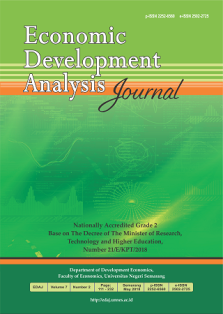Large Dams and Welfare : Empirical Study in Indonesia
Bendungan Besar dan Kesejahteraan : Studi Empiris DIi Indonesia
Abstract
In addition to solving the problem of water shortage for irrigation, energy and consumption, the
policy of building large dam is also expected to improve population-welfare. However, previous
studies suggest that people living near dams have less benefit from the existence of large dam. This
study aims to provide empirical evidence the effect of large dam development on welfare to
household living in sub-districts around large dam placement using National Socio-Economic
Survey (SUSENAS) data in 2013-2018 from Central Bureau of Statistics and spatial large dam data
in Indonesia. Estimated results indicate that addition large dam tend to be negatively correlated by
2.4-3.1 % with household consumption implying a tendency of decreasing welfare in local
households. Estimated findings using Indonesia Family Life Survey (IFLS) in 2007 and 2014 show
negative correlation likely to be caused by lower agricultural productivity and work activity. This
result show there are economic agents who suffer from large water - infrastructure especially
households living in sub-districts close to the dam.


